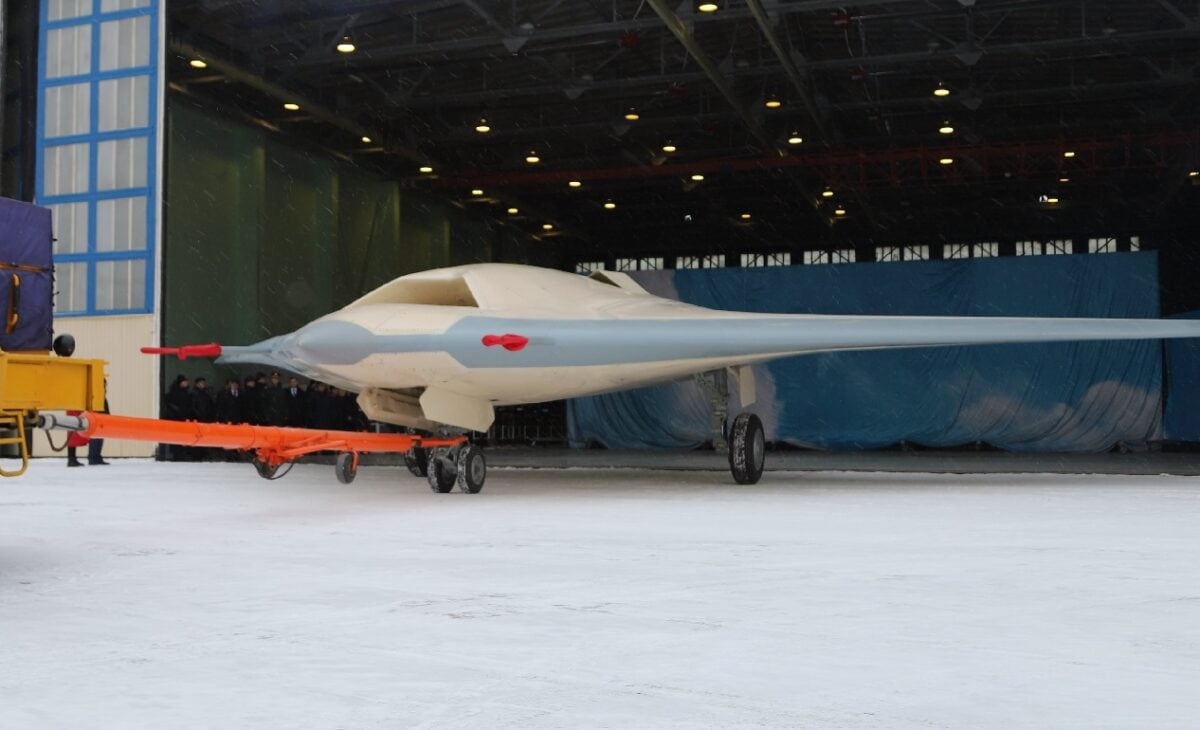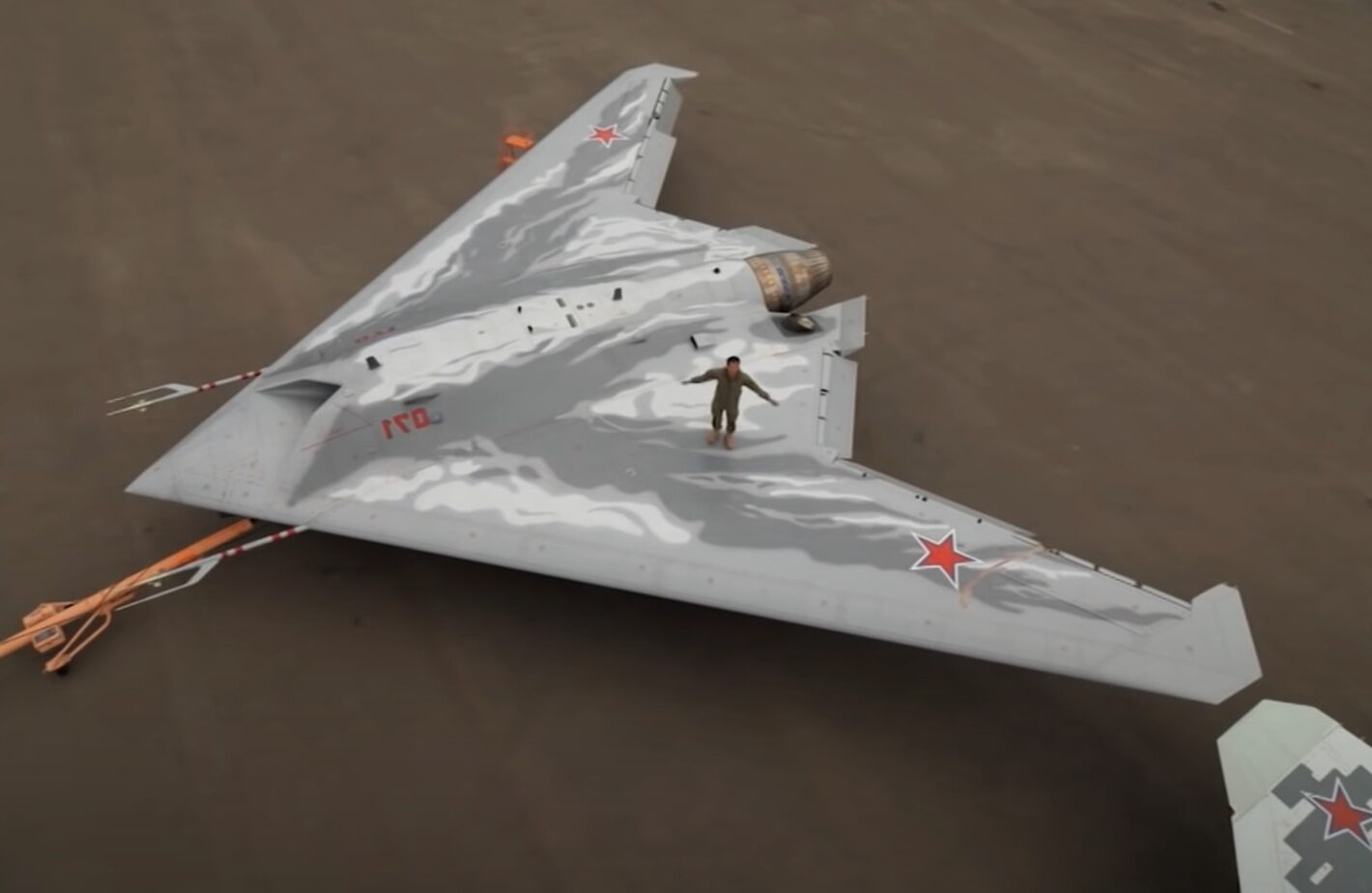A hunter needs to hunt. Russia’s S-70 Okhotnik-B (Hunter) combat drone is waiting for that game-changing deployment that could shift the balance over Ukraine. The problem is that it is not ready and is still in test mode. It may not enter service until next year or even in 2024, although we saw glimpses of it in training earlier this year with Russia’s Su-57 stealth fighter practicing a “loyal wingman” mode.
Team Up With New Next-Generation Fighter
The idea for the Okhotnik-B is to improve situational awareness for Russia’s next-generation airplanes by extending the range of radar and weapons to help it engage more targets for each mission of the Su-57. The Okhotnik-B also tested its air-to-air missiles earlier this year giving it a high-flying combat capability. The heavy unmanned craft is based on the Mikoyan Skat. It can be compared to the Boeing Loyal Wingman drone (Airpower Teaming System). It also slightly looks like the Northrop Grumman’s X-47B or Lockheed Martin’s RQ-170 Sentinel.
Powerful Engine Gives It Great Range
The 20-ton S-70B is thought to be propelled by the AL-31F turbofan engine (same as on the Su-27 fighter) or the AL-41F (same as on the Su-57). It has an impressive extended range of 3,728 miles and a combat range of 2,485 miles. The cruising speed is 621 miles per hour.
How Stealthy Is the S-70?
The Okhotnik-B is believed to be somewhat stealthy with its flying wing design and 57-foot wingspan, but as Alex Hollings has written in Sandboxx News, the “clearly visible jet nozzle on the back of the aircraft would not only offer a significant radar return, it would also make direct line-of-sight infrared detection pretty easy.”
U.S. Loyal Wingman Program Has Been More Successful Due to AI
The Russian drone will likely be used more to enable stand-off over-the-horizon missile launches than to engage in direct aerial combat with other fighters. Also, the United States is ahead of Russia in the use of simulated combat between drones and American fighters. The U.S. Air Force is using the Skyborg artificial intelligence system to advance the air-to-air capability of the loyal wingman drones.
So Far, So Good on Testing for the S-70 Russian Drone
The first flight of the Okhotnik-B happened in 2019 after ground tests the previous year. The first loyal wingman test was conducted in 2019 as well. While serial production is not expected to commence until 2024, the combat drone could be tested over Ukraine next year.
Advanced Munitions Could Make a Difference for S-70
The 45-foot-long unmanned bird will carry some sophisticated and potent weaponry. Air-to-surface missiles will be on board in internal bays. Precision-guided bombs can be dropped. This includes a deadly high-fragmentation high-explosive incendiary bomb and the dangerous fuel-air-explosive bomb, according to GlobalSecurity.org. The Okhotnik-B passed a test in May by showing off precision ground strikes.
S-70: What About Ukraine?
Would the Okhotnik-B take a solo flight and deploy its weapons over Ukraine? That could be a possibility, but the pairing with the Su-57 could take longer due to the sophistication needed for the teaming system to work properly. Russia could use a shot in the arm to its air force. The conventional fighter planes are struggling, especially the vaunted Su-35 warplane that has been mostly a failure during the war.

S-70 Okhotnik. Image Credit: UAC Russia.
Russia may desire to keep the Okhotnik-B flying over Russian air space only in order to avoid being shot down since the unmanned bird is not fully stealthy. The Ukrainians would love for the Okhotnik-B to fail on the global stage. Global financial sanctions could keep the combat drone on the ground too. The Russian defense industrial base is also not known for avoiding delays and cost overruns. But the Okhotnik-B may be different if its testing activity is true. Russia may have a drone that could help the Su-57 penetrate contested air space by sneaking through air defenses and destroying targets in the air and on the ground, which would give the Russian air force a much-needed boost to its air force procurement efforts, even if it does not fly over Ukraine next year.
Expert Biography: Serving as 1945’s Defense and National Security Editor, Dr. Brent M. Eastwood is the author of Humans, Machines, and Data: Future Trends in Warfare. He is an Emerging Threats expert and former U.S. Army Infantry officer. You can follow him on Twitter @BMEastwood. He holds a Ph.D. in Political Science and Foreign Policy/ International Relations.

